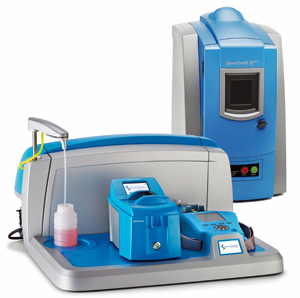MiniLab Allows On-Site Oil Analysis for Rapid Determination of Machinery Health
![]() Print this Article | Send to Colleague
Print this Article | Send to Colleague
 Spectro Scientific, Chelmsford, Mass., USA, has introduced the MiniLab 153 oil analysis system, enabling reliability and maintenance professionals to quickly and accurately perform comprehensive on-site lubricant analysis.
Spectro Scientific, Chelmsford, Mass., USA, has introduced the MiniLab 153 oil analysis system, enabling reliability and maintenance professionals to quickly and accurately perform comprehensive on-site lubricant analysis. Following Spectro’s successful introduction of the MiniLab 53 last year, the new MiniLab 153 extends the product line by adding an elemental analyzer for the detection of contaminants, additives, and wear metals. The new trace elemental capability is derived from the line of Spectroil Q100 RDE-OES (rotating disc electrode optical emission) spectrometers.
The MiniLab153 system is easy to operate and allows plant personnel with minimal training to perform consistently accurate analyses. A complete lab-quality measurement can be obtained on-site in less than 20 min.
The MiniLab 153 analyzes oil for contamination, chemistry, and machinery wear by integrating instrumentation for particle count, viscosity, infrared spectroscopy, ferrous wear, and wear particle characterization. The MiniLab Series generates easy-to-interpret results and reports with OilView™ analytical software, which includes asset management and reference oil databases, alarm limit templates, Trivector™ report creation, automatic email report distribution, and data analytics.
Wear and corrosion of lubricated surfaces in machinery are the root causes of most mechanically-induced equipment downtime. Oil analysis provides early indications of equipment wear and identifies the sources of corrosion. Timely analysis is essential because the condition of machinery can change significantly during the wait for oil sample results to return from external laboratories. Immediate, on-site analysis enables rapid decision making to determine urgent or preventative maintenance actions.
Lubricant oil analysis is a critical part of predictive maintenance (PdM) programs since it increases equipment availability by reducing unexpected failure, facilitates proactive maintenance schedules based on predictive analytics, extends equipment life, and decreases total equipment lifecycle costs.
More information is available online.


